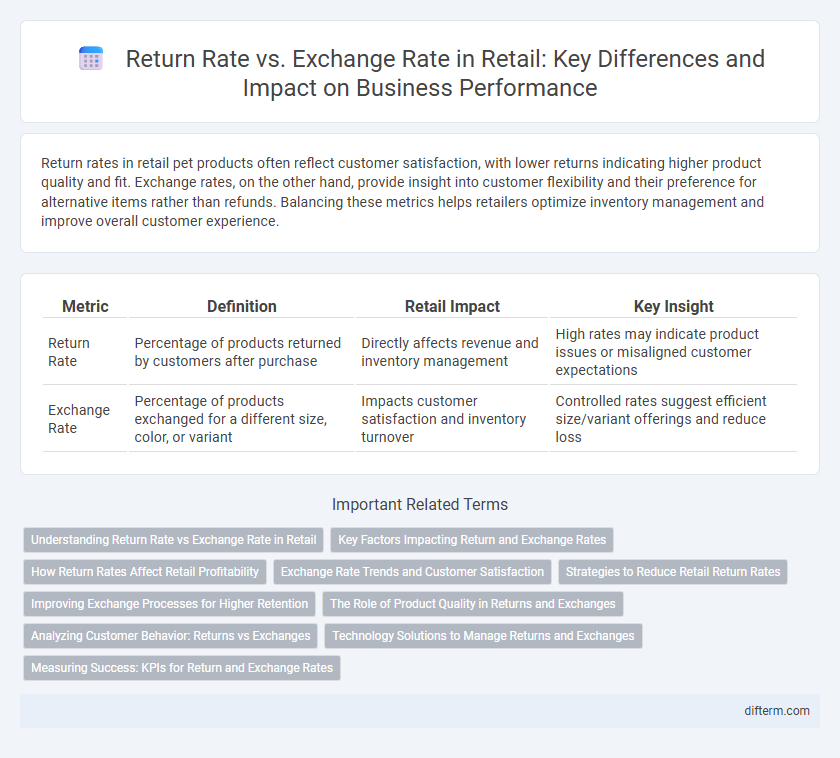Return rates in retail pet products often reflect customer satisfaction, with lower returns indicating higher product quality and fit. Exchange rates, on the other hand, provide insight into customer flexibility and their preference for alternative items rather than refunds. Balancing these metrics helps retailers optimize inventory management and improve overall customer experience.
Table of Comparison
| Metric | Definition | Retail Impact | Key Insight |
|---|---|---|---|
| Return Rate | Percentage of products returned by customers after purchase | Directly affects revenue and inventory management | High rates may indicate product issues or misaligned customer expectations |
| Exchange Rate | Percentage of products exchanged for a different size, color, or variant | Impacts customer satisfaction and inventory turnover | Controlled rates suggest efficient size/variant offerings and reduce loss |
Understanding Return Rate vs Exchange Rate in Retail
Return rate in retail measures the percentage of products customers send back after purchase, reflecting customer satisfaction and product quality. Exchange rate indicates the proportion of returned products that customers replace with alternative items, highlighting customer preference for retention over cancellation. Analyzing both metrics helps retailers optimize inventory management, improve product offerings, and enhance customer loyalty strategies.
Key Factors Impacting Return and Exchange Rates
Return rate and exchange rate in retail are influenced by product quality, customer satisfaction, and clarity of return policies, which directly affect customer trust and purchasing decisions. Seasonal trends, promotional campaigns, and inventory management also play crucial roles by impacting the volume and timing of returns or exchanges. Effective staff training and streamlined logistics reduce processing time, enhancing overall customer experience and minimizing return-related losses.
How Return Rates Affect Retail Profitability
High return rates significantly diminish retail profitability by increasing operational costs and reducing net sales revenue. Managing exchange rates impacts pricing strategies for international retailers but does not directly affect return-related expenses. Retailers must optimize return policies and improve product quality to minimize returns and protect profit margins.
Exchange Rate Trends and Customer Satisfaction
Exchange rate trends significantly influence customer satisfaction by determining the ease and cost-effectiveness of product exchanges in retail. Higher exchange rates often correlate with smoother transaction processes, encouraging repeat purchases and enhancing brand loyalty. Monitoring these trends enables retailers to optimize exchange policies, ultimately reducing return rates and improving overall customer experience.
Strategies to Reduce Retail Return Rates
Implementing clear product descriptions and high-quality images significantly reduces retail return rates by aligning customer expectations with actual products. Investing in customer feedback systems and data analytics helps identify common return reasons, enabling targeted improvements in product design and inventory management. Enhancing exchange policies with streamlined processes encourages exchanges over returns, maintaining customer satisfaction while minimizing revenue loss.
Improving Exchange Processes for Higher Retention
Streamlining exchange processes reduces friction, leading to higher customer retention and improved brand loyalty. Efficient return-to-exchange conversions can decrease overall return rates by encouraging customers to opt for product exchanges instead of refunds. Leveraging automation and clear policies enhances the customer experience, driving repeat purchases and sustaining revenue growth in retail.
The Role of Product Quality in Returns and Exchanges
High product quality significantly reduces return rates by meeting or exceeding customer expectations, leading to fewer defects and dissatisfaction. Conversely, superior product durability and performance often result in higher exchange rates as customers seek different sizes, colors, or variants rather than rejecting the product altogether. Retailers focusing on quality control experience lower overall returns and benefit from increased customer loyalty through smoother exchange processes.
Analyzing Customer Behavior: Returns vs Exchanges
Return rates in retail measure the percentage of products customers send back, while exchange rates track items swapped for alternatives, revealing distinct consumer preferences. Analyzing these metrics uncovers patterns in purchasing behavior, such as dissatisfaction due to size or quality issues leading to returns versus the desire for different styles prompting exchanges. Understanding the correlation between high return rates and low exchange rates can guide inventory management and personalized marketing strategies to enhance customer satisfaction.
Technology Solutions to Manage Returns and Exchanges
Advanced technology solutions such as AI-powered return management systems and automated exchange platforms significantly reduce return rates by enhancing product matching and customer satisfaction in retail. Leveraging data analytics and machine learning algorithms improves the accuracy of return predictions, streamlines inventory updates, and accelerates customer service response times. Integrating these technologies into e-commerce and point-of-sale systems optimizes the efficiency of processing both returns and exchanges, ultimately boosting operational performance and reducing associated costs.
Measuring Success: KPIs for Return and Exchange Rates
Return rate and exchange rate are crucial retail KPIs that directly impact profitability and customer satisfaction. Monitoring return rate helps identify product quality issues and inventory inefficiencies, while exchange rate analysis reveals customer preferences and the effectiveness of sizing or product descriptions. Optimizing both rates through data-driven strategies enhances operational efficiency and drives sustainable revenue growth.
Return Rate vs Exchange Rate Infographic

 difterm.com
difterm.com